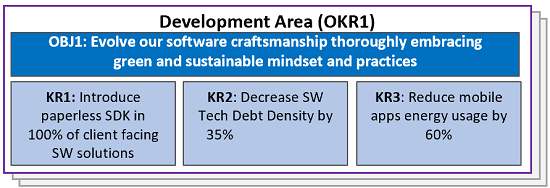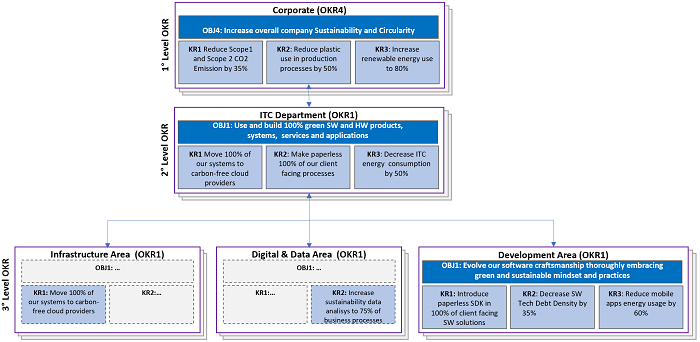OKRs (Objective and Key Results) can be considered a Lean-Agile management practice which helps companies define corporate goals and outcomes to be achieved, which fosters overall accountability, focus and alignment. In this post we describe how OKRs can be used to drive transformation towards sustainability as well as the end-to-end process: from OKR creation down to results measurement.
![]()
Natural resource depletion and climate change are challenging the traditional Linear Economy model used so far worldwide. Companies are facing increasing pressure from employees, customers, suppliers and investors to adjust their businesses towards Circular Economy:
“a way of doing business that aims to keep resources in use for as long as possible, and in which products and materials are recovered and regenerated at the end of their service life”
For most organizations, this change can mean a tough and discouraging transformation, disseminated of risks and challenges, which regards their current business models, processes, culture, the whole supply and value chains.

We know, however, that behind any risk opens up an opportunity which waits to be exploited: the bigger the risk, the higher the opportunity.
The journey towards sustainability and circular economy requires great visionary capacities (strategy), high creativity in exploring unknown territories (innovation), high focus in acting (execution), perseverance in comparing expected results with actual ones (measurement), always being ready to pivot any time the context and situation change.
 Today increasing numbers of companies are adopting OKRs for driving their own business.
Today increasing numbers of companies are adopting OKRs for driving their own business.
What we see in our daily job is that many of them, among their business objectives, are dedicating one or more of their corporate OKRs to drive the change towards sustainability and circular economy, leveraging their high pervasiveness and ability to involve and engage the whole company, which is actually peculiar to this framework.
OKRs: Quick Recap
OKRs combine both strategic and tactical elements to create and define a goal in a comprehensive, clear, and challenging way
An OKR is made of two parts: the Objective and relative (3-5) Key Results.

An example is:
Objective: “Customers” is our boss
- Key results #1: Collect feedback from 20 customers/month
- Key results #2: Boost customer retention to 97%
- Key results #3: Increase NPS from 8.5 to 9
Once a company sets their own OKRs, they should be used then to identify what activities/initiatives to execute to reach those results.

Corporate OKRs: Sustainability Example
When companies define OKRs we usually have a mix of business, organizational and cultural ones.
Here below an example of OKRs of an imaginary CirculAgility S.P.A. Company (1st Level):

And then, hopefully, they introduce an OKR that pursue sustainability:

Once OKRs at Corporate level have been defined, they have to be communicated to the whole company and make them visible to everyone. This helps employees understand where the company is heading and how each one can contribute with their daily work.
2nd Level OKRs
Now, it’s the time for Business Units and other Corporate Functions to create their own OKRs (2nd level) declaring how they want to contribute to the achievements of corporate targets; this is called “Top-Down, Bottom-Up and Horizontal Alignment”.
Getting back to our imaginary CirculAgility company, let’s say that the Packaging Department of the company want to align with the corporate OBJ4.KR2 (Reduce plastic use in production processes by 50%), and formulates its own Sustainability OKR as follows:
Objective: We want to significantly contribute to the reduction of plastics in the oceans, while reducing packaging costs
- Key results #1: Reduce single-use plastic packaging by 25%
- Key results #2: Incorporate 70% recycled content into product packaging
- Key results #3: Reduce average weight of our packaging by 20%
If we then focus for a moment on the ITC Department, their Sustainability OKR can be stated as follows:

3rd Level OKR
If we remain inside the ITC Department, at this point each internal areas (e.g. Infrastructure, Digital & Data, Development, etc.) should, in turn, develop their OKRs.
The Development Area, for example, decided they want to go paperless for 100% of their client facing solutions, reducing energy usage of their mobile apps by 60% and reduce technical debt by 35%, actually decreasing rework, bugs and time (and energy) necessary to fix and refactor source code:

The process creation of OKRs (at least of the Sustainability ones and for the ITC Development Area) reached its 3rd level; the overall picture is as follows:

Initiatives Identification
OKRs are a very powerful tool. They assure strong company’s objectives alignment and focus.
But, what about results? How did we achieve the results that we so precisely have identified and expressed in numbers or percentages? How we can avoid to make the become wishful thinking, a vain effort?
Well, reached this point, it’s time to identify the relevant and concrete initiatives the company needs to execute for reaching those results. The ITC Development Area and its teams, for example, identified the following initiatives according to each KRs:
- KR1: Introduce paperless technology in 100% of our SW solutions
- Introduce Paperless API / SDK in Order Management and Warehouse applications
- Introduce Digital Signature APIs in Mobile Apps
- KR2: Decrease overall applications’ Tech Debt Density by 35
- Extend SonarQube static code analysis and remediation tools to all SW dev Teams
- Introduce TDD, BDD, CI and CD practices to all SW dev Teams
- Refactor Billing, CRM and Warehouse applications to decrease Tech Debt by 45%
- KR3: Reduce mobile apps energy usage by 60%
- Introduce «GreenSW CarbonTracker» in all our Mobile apps
- Introduce «GreenSW CO2Scope» to monitor real-time CO2 emissions of virtual servers
- Adopt «GreenSW Carbon Aware SDK» in our SW development lifecycle
The initiatives thus identified, should be then collected into a portfolio, prioritized and the most important and promising funded and executed. For more information about Lean Portfolio Management see these post:
- Adaptive Strategy: combining OKRs with Lean Portfolio Management
- Three Lean Portfolio Management practices your organization should adopt – Now
OKR Check-ins
As initially written, Key Results need to be quantitative and measurable. Now that OKRs and related initiatives have been identified, it’s “only” about execution and measurement.
Check-ins are recurrent events (weekly, bi-weekly, monthly or quarterly, it depends) where teams, areas and the company itself, verify if and how the initiatives under execution are actually bringing the expected results, by collecting data and measuring their progress.
These moments can be thought as retrospective moments where any impediment is assessed and improvement actions identified, They usually ends with a confidence vote which expresses if the team sees each Key Results still achievable. If the confidence is low, the team thinks if the Key Result is still relevant and decides if it is necessary any changes.
If you you’ve come this far, you might be interested in reading additional posts on how Agile can boost Sustainability and Circular Transformations:
- Agile for Sustainability
- Agile for Sustainability – Declaration of Intent
- 3 Tools to inject Sustainability and Circularity into your Business
Enjoy!


